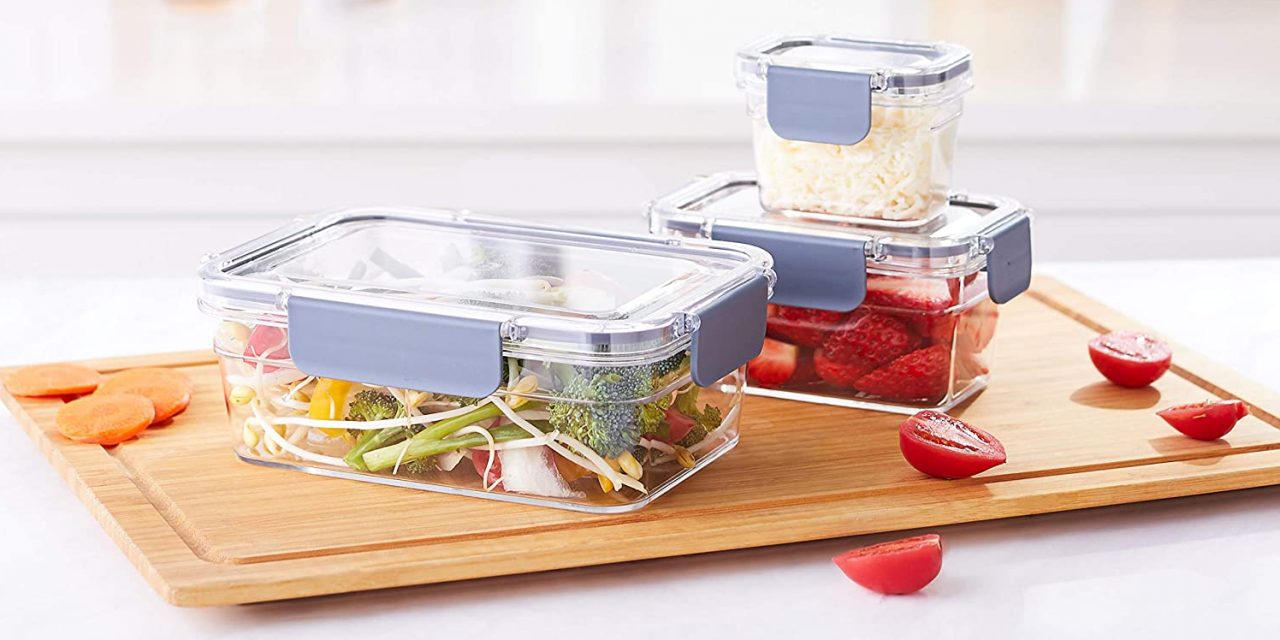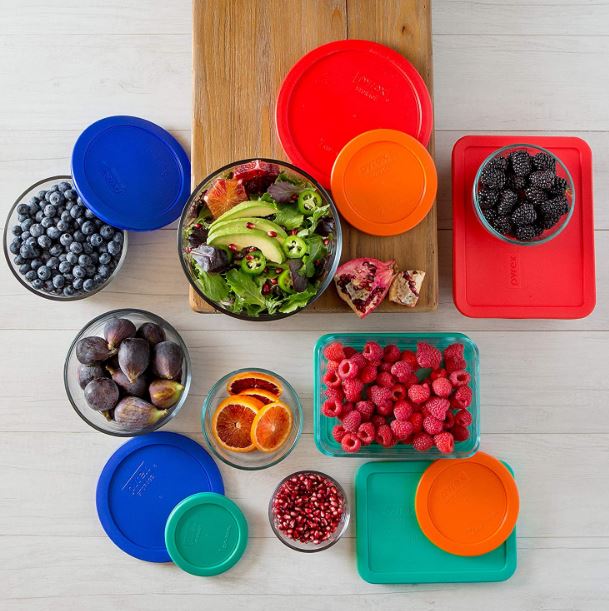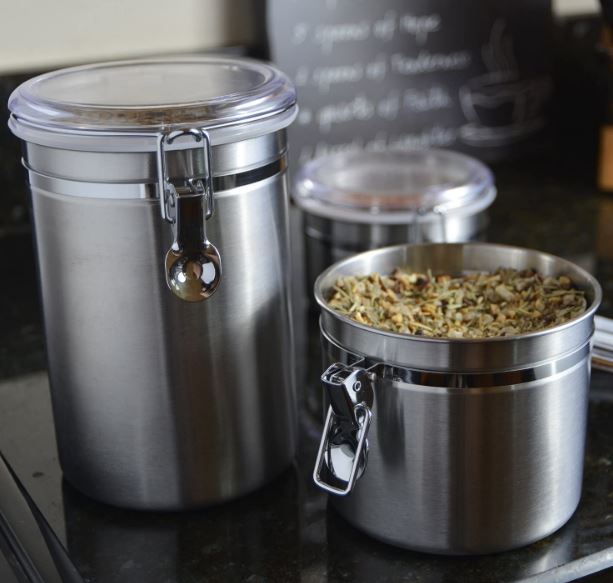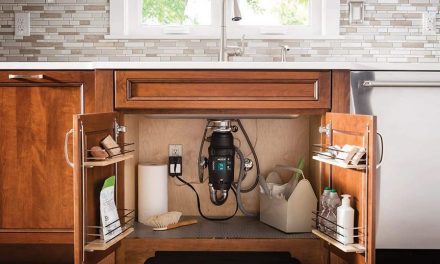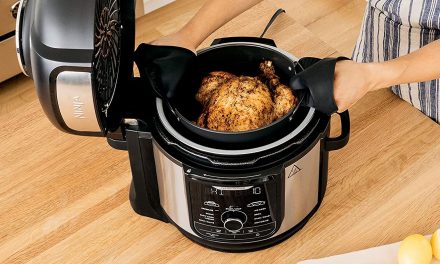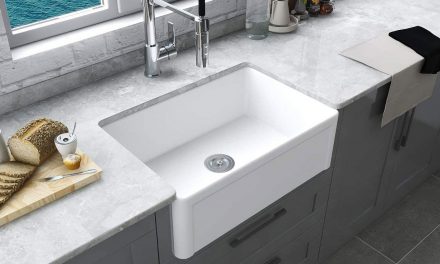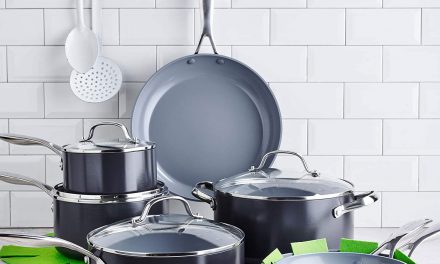From leftovers to staples, food storage containers are a vital part of a working kitchen. They help food last longer, keep pantries and refrigerators more organized, and help cut down on wasteful and expensive single-use containers.
In this article we’ll cover what to look for in food storage containers. We’ll talk about which materials are best for different uses and how many containers you really need. But first—which sizes and shapes are best for you?
Table of Contents
Food storage container sizes and shapes
Food storage containers come in many different sizes and shapes. Some are best suited for long-term bulk or dry food storage in a pantry, while others are best for keeping fresh food in the refrigerator. Most kitchens benefit from having a variety of container sizes made from different materials.
When buying a container set, many will come with multiple sizes, from small to large, fat and skinny. Capacity can range from small sauce dishes, to individual meal-sized containers, and even large vessels intended for bulk storage or dry good storage.
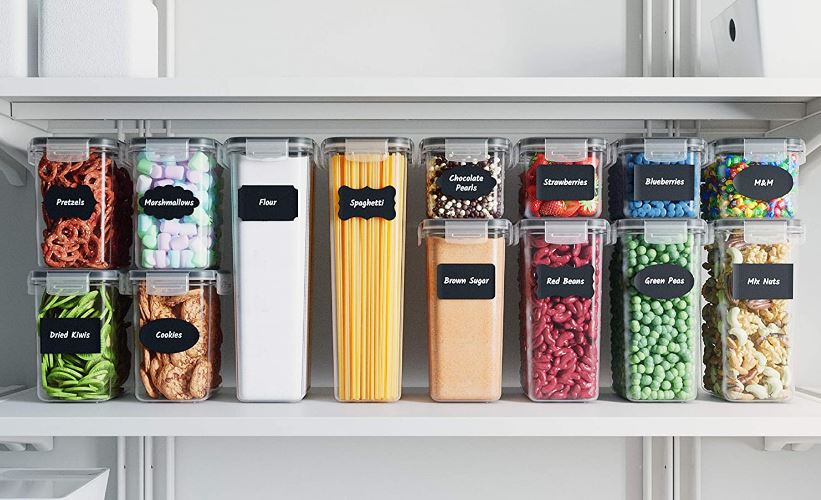
See the 14-piece Chef’s Path food storage set
Only you can know what’s right for your kitchen, but consider that the largest container sets may come with very small and inconvenient sizes. You’ll probably find medium- to large-sized containers far more useful.
- Check out the best selling food container sets on Amazon
- Looking for jars and canisters specifically? See here
Types of food storage container materials
Outside of size and shape, it’s a container’s material that most clearly dictates how it can and should be used (or not used). Different materials have different pros and cons, but for most kitchens, glass and plastic will cover all your typical needs. Ceramics and metals have their niche uses, too, but in many kitchens their advantages are aesthetic alone.
Glass containers
So long as you don’t mind the weight, glass containers are good for just about everything in the kitchen.
US-based Pyrex and Rubbermaid are two brands that standout from the bunch. Both companies have been in business for 100 years or longer, all thanks to years of manufacturing durable products.
Another standout brand is the Korean-made Glasslock. The company has a generous free lid replacement policy, which is nice to have considering the plastic lids on glass containers are often the only component that breaks down over time or picks up odors.
Another kind of glass food container is the Mason jar, which can be used for everything from storing dry goods to pickling and canning.
Pros:
- Easy to see what’s inside
- Scratch and stain resistant
- Doesn’t pick up food odors/colors
- Can be oven safe (depending on the glass)
- Dishwasher safe (though some plastic lids may not be)
Cons:
- Heavier
- Thinner, cheaper glass breaks easily
- Easily breaks or shatters if dropped
- More expensive than plastic
Price range: Affordable; $30-$50 for most glass container sets
Plastic containers
While plastic containers are sometimes called Tupperware, this is actually a brand name.
Plastic containers are great for when you need something light and durable, and they’re cheap enough that you won’t feel bad when a child inevitably loses one after school lunch.
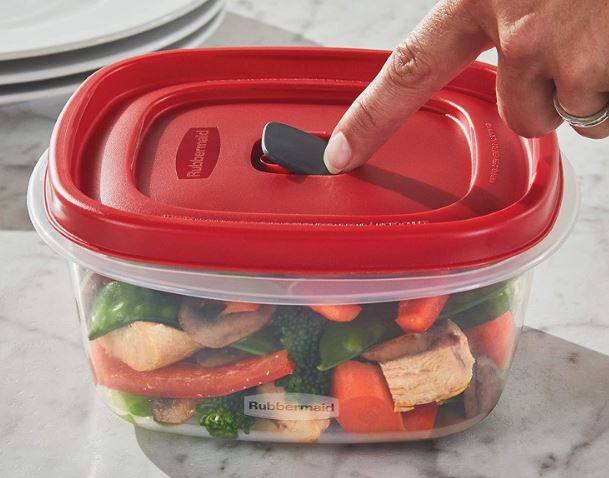
See Rubbermaid’s 8-piece meal prep container pack. Its vented lids make it perfect for splatter-free microwaving.
Rubbermaid plastic containers often stand out from others for their durability, smart designs, airtightness, and leak-proofing. As a bonus, Rubbermaid products are made in the USA.
Pros:
- Microwaveable
- Lighter
- More durable
- Cheaper than glass
- Typically dishwasher safe
Cons:
- Can be hard to see what’s inside (depending on the plastic used)
- More likely to pick up odors over time
Price range: Very affordable; $15-$40 for most plastic container sets
Is “BPA-free” actually safe?
BPA (Bisphenol A) is a primary component of a variety of plastics that has largely been phased out from food-grade plastics after health concerns were raised. Since then, a number of alternatives have become more prominent in the market, though it is worth noting that the European Food Safety Authority (EFSA) has concluded that BPA exposure from dietary sources is well below dangerous levels, anyway. If you’re still concerned, though, there are many alternatives.
Unfortunately, several studies suggest common BPA replacements, like BPS and BPF, may have similar effects. Further research will tell us more about the effects of these plastics on the body. If you’re very concerned about this, stick with glass. Other than when it breaks, glass is the most versatile and the safest food storage container available right now.
The best way to ensure your plastic food storage containers are safe is to check the resin identification code. The most food-safe plastics are PETE (polyethylene terephthalate) and HDPE (high-density polyethylene), designated by the code as 1 and 2, though PETE is not recommended for reuse. The toxicity of LDPE (low-density polyethylene) and PP (polypropylene), designated by 4 and 5, has varied more in testing, and more research is needed, but they are still generally considered to be safe.

The numbers stamped on the bottom of plastic containers and bottles tell you what they are and whether they can be recycled or reused. (Source: Portland Gov.)
What plastic containers can be reused?
While it might seem thrifty to reuse old margarine or yogurt containers for food storage, it’s not safe. These plastics are meant for single-use and break down quickly over time, especially when exposed to soaps, hot water, and microwaves.
If your container has a 1, 3, 6, or 7 stamped on its bottom, it should not be reused. You should recycle it.
Ceramic containers
Ceramic crocks and jars are a great option for food storage and are especially good for long-term storage. If you’re concerned about plastics leaching chemicals into your food, glass is a good option, but so, too, are ceramic containers. As a bonus, they prevent light from degrading food quality. However, this also means you’ll have to open them occasionally to make sure food’s still fresh.
Look for ceramic products that are lead-safe, though keep in mind that ceramic containers can contain trace amounts of lead. To be food safe, a ceramic container’s glaze must be intact and free of leachable toxins. The ceramic itself must also be extremely low in heavy metals in case the glaze cracks. If you’re looking for a good way to track safety, look for ceramic containers that meet California’s rigorous lead safety standards.
Anchor Hocking is better known for their glass containers, but their ceramic storage sets are a popular option—and they’re manufactured in the US. Home Basics also offers a 4-piece ceramic storage set which comes in numerous colors, from bright red, to mint, and black.
Notable, some fermentation kits, like Humble House’s, come with stoneware crocks for sauerkraut.
Pros:
- Oven and microwave safe
- Keeps away light
- Sturdy
Cons:
- Heavier
- May chip when dropped
- More expensive than glass or plastic
- Not generally stackable
Price range: Expensive; often $25-$40 or more for individual canisters or small sets
Metal containers (stainless steel, copper)
Metal food storage containers are a good, durable option, especially for longer storage and dry goods. Metal containers are great for coffee, tea, spices, and anything that lasts longer when kept away from light and heat.
Anchor Hocking also manufactures metal storage containers, and their stainless steel sets are consistently rated well. If you prefer a vintage style of container, Old Dutch offers a variety of hammered metal containers designed with aesthetics in mind.
For best storage results, choose stainless steel or stainless steel lined containers. Some may be lined with plastic.
Pros:
- Oven and stovetop safe
- Very durable
- Lightweight but still strong
- Keeps away light
- Stainless steel is non-reactive and won’t stain
Cons:
- Not microwave safe
- Some popular sets are not dishwasher safe
- Some metals (like copper and aluminum) can react with acidic foodstuff
- Tend to be pricey
Price range: Somewhat expensive; around $15-$40 for stainless steel canisters or sets. Other metals are harder to find and more expensive.
What to look for in food storage containers
Airtightness and leak proofing: Most food containers claim to be airtight and leak-proof, but in kitchen testing this hasn’t always been found to be true. If either of these features is especially important to you, stick with higher-quality name brands and know that plastic isn’t as airtight for long-term storage as glass or stainless steel containers.
Temperature safety: Not all containers are freezer or oven safe.
Stackability: Have a small fridge or pantry? Stackable containers allow you to keep more in tight spaces. They’re particularly great if you like to prepare meals ahead of time to enjoy later throughout the week.
Shape: The shape of your container can greatly affect your use of it. If you need to reach in a container with a large measuring cup, for example, stick with square/rectangular shapes. But if large measurements aren’t important, and you’re simply going for clean aesthetics, round canisters are perfectly fine for a pantry.
Lid durability: For most containers, it’s the lid you’ll be interacting with most as you remove it and replace it, time and again. Fragile lids can warp or weaken over time and become a hassle, and don’t underestimate the frustration that comes from lids that fit poorly. Snap-on lids are a great choice, provided the materials are good.
Ease of cleaning: Not all containers are dishwasher safe, and lids may need to be hand washed.
Measurement markers: If you like to measure out food precisely for portion control, look for containers that have markers on their sides for cups, quarts, and/or liters.
Food storage containers made in the USA
Looking to buy American? When it comes to food storage, you actually have quite a few brand options.
- Anchor Hocking began with a merger between the Hocking Glass Company (founded in 1905) and the Anchor Cap and Closure Corporation in 1937. Though they started in glass making, they now produce several varieties of ceramic and stainless steel pantryware.
- Ball and Kerr are industry leaders in mason jars and mason jar accessories. The Ball Corporation was founded in 1890 and improved on the original design for the mason jar. Alexander Kerr founded the Hermetic Fruit Jar Company in 1903, and they’re both still manufactured in the US.
- The Pyrex brand originated in 1915 and sells a wide variety of glass and plastic homeware products. Introduced by Corning, it’s now manufactured by Corelle at their factory in Charleroi, Pennsylvania. Snapware, a subsidiary brand of Corelle, is known for their modular, ‘snappable’ plastic storage containers.
- Rubbermaid was founded in 1920 in Wooster, Ohio as a rubber company but has since expanded to a wide range of plastic and glassware. While their raw materials are sourced from all over the world, most of their food storage containers are manufactured in the US.
- Tupperware was founded by Earl Tupper in 1948. Popularized through its ‘tupperware party’ promotional scheme, it has become a generic term for plastic, snap-on-lid storage containers. Tupperware continues to this day, though, through its FridgeSmart, Wonderlier, and FlatOut lines, among several others.
Food storage containers starter kit
Looking for a quick and easy way to make sense of your kitchen’s mayhem? Cut to the chase and consider buying the following:
- If you meal prep, get a good stackable set of containers. Glass sets, like this 8-piece leak-proof set from Rubbermaid, are great if you’re not worried about them breaking or aren’t planning for children to use them. If you need plastic meal prep containers, consider Rubbermaid’s 5-piece plastic set instead.
- Looking to organize your dry goods in your cabinets or pantry? Get a larger plastic container set, like this 14-piece set from Chef’s Path, which comes with labels. Larger storage sets allow you to store a variety of goods, from cereals, to pastas and beans. If you’d prefer glass, expect to spend more for fewer pieces, but consider this 5-canister glass set with bamboo lids. Don’t forget Mason jars can be a great option, too.
- Planning big things in advance? For long-term bulk storage, you want large, airtight containers that will protect your food from the light. Containers made of stainless steel or ceramic are great for this.

